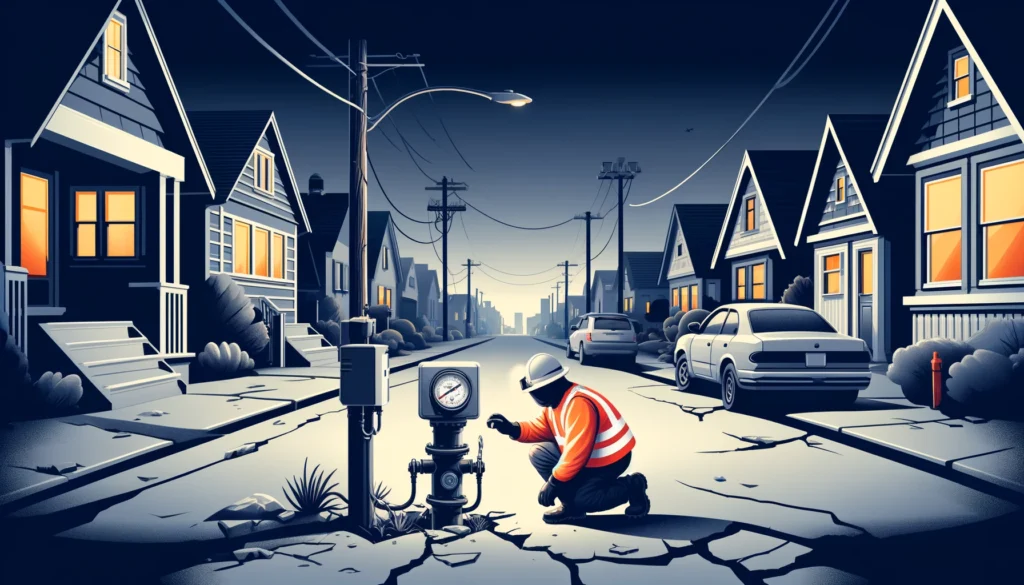Living in the Bay Area comes with undeniable perks, but also with the reality of earthquake risk. While we can’t control the earth’s movements, there are steps we can take to mitigate potential damage after a tremor. One example is the installation of seismic shut-off valves, which can significantly reduce the risk of post-earthquake fires and explosions.
In this blog post, we’ll navigate the regulations surrounding these valves, exploring where in the Bay Area they’re mandatory and why they’re such a crucial safety measure.
SEISMIC VALVE REGULATIONS ACROSS THE BAY
CONTRA COSTA COUNTY
According to the Contra Costa County Municipal Code 718-8, in Contra Costa County, buildings with new or significantly modified gas piping systems—whether residential, commercial, or industrial—must have a special safety valve installed just past the gas meter. You can choose from two types of valves:
- Seismic shut-off valve: This is sensitive to movement and will automatically shut off the gas if it detects shaking from an earthquake.
- Excess flow gas shut-off valve: This type reacts to changes in gas flow, shutting off if there’s a sudden surge that could indicate a leak or break in the pipe.
These valves are essential for safety and are required in any new construction or major renovations that meet certain cost thresholds. Additionally, they might need to be installed when a property is sold to ensure the new owners have a safe environment.
Different cities within the county have varied thresholds for when these installations are required based on the valuation of construction or renovation projects:
- Lafayette: No valve requirement at the meter unless appliances are affected, with a threshold of $15,000.
- Moraga: Requires a valve at the meter for projects involving gas piping starting at a $5,000 threshold.
- Orinda and Clayton: Similar requirements to Moraga with thresholds for gas-related projects set at $5,000.
Building permits for these installations can be applied for through the corresponding city or county.
ALAMO
Living in Alamo’s unincorporated areas of Contra Costa County means following specific rules for buildings with gas lines. Here’s the key takeaway: most buildings need a gas shutoff valve installed.
As of January 2017, all residential, commercial, or industrial buildings in Unincorporated Contra Costa County Ordinance areas must have gas shut-off valves installed.
This regulation is particularly important for any property transaction involving these buildings. If a building has been sold on or after December 1, 2006, it must have a gas shut-off valve installed to comply with local ordinances. To ensure compliance, the installation of this device must be completed before the sale agreement is finalized or before the closing of escrow.
This requirement helps to safeguard new owners by ensuring that their property is equipped to automatically shut off the gas supply in the event of a leak or seismic activity, enhancing safety and minimizing potential hazards.
DANVILLE
Since July 1, 2007, Danville requires that all building permits valued over $10,000 include the installation of approved seismic shut-off valves. This mandate came into effect following the adoption of Ordinance 2007-02 by the Town Council in May 2007, which stipulates the installation of either a Seismic Gas Shut-Off Valve or an Excess Flow Valve.
Installation of these seismic shut-off valves must be done by a licensed plumbing contractor, ensuring that the work is performed correctly and complies with local safety regulations. The cost for installation can vary depending on the gas piping configuration at the meter.
For those looking to install these safety devices, a variety of seismic shut-off valves approved by the California Division of the State Architect are available. These can be obtained from plumbing supply retailers or licensed plumbing contractors. For more detailed information on specifications and approved models, you can contact the Division of the State Architect at (916) 327-0535 or visit their website.
These regulations are part of Danville’s commitment to ensuring the safety of its residents and businesses by mitigating potential hazards associated with gas leaks, especially in the aftermath of seismic events.
LAFAYETTE
In Lafayette, regulations specify that approved excess flow gas shut-off devices must be installed to enhance safety in various types of buildings.
APPLICATION OF REGULATIONS:
- New Construction: Any new commercial, industrial, or residential building that includes fuel gas piping must have an excess flow gas shut-off device installed upstream of any vulnerable appliance fuel connector. This installation is mandatory for buildings where the building permit is issued on or after the ordinance’s effective date.
- Existing Residential Buildings: For any existing residential buildings undergoing renovations involving gas piping, these devices must be installed at each gas appliance that uses a vulnerable appliance fuel connector. This requirement applies specifically to the individual units undergoing renovation, ensuring localized safety measures.
- Significant Renovations: In residential buildings where renovations or additions do not involve gas piping but exceed a valuation of $15,000, excess flow gas shut-off devices must still be installed at each gas appliance within the units being modified.
- Commercial and Industrial Buildings: Similar requirements apply to existing commercial or industrial buildings undergoing work that involves gas piping. Here, the devices need to be installed for each appliance in the units or tenant spaces affected by the issued building permits.
- High-Value Alterations in Commercial/Industrial Buildings: For alterations or additions over $15,000 where no gas piping is involved, the regulations still necessitate the installation of these safety devices at each gas appliance in the affected units or spaces.
EXCEPTIONS AND COMPLIANCE:
- Exceptions: Devices installed before the effective date of this chapter are exempt from the new requirements but must be maintained for the lifetime of the building.
- Compliance: All installed devices must meet the criteria set by the State Architect or an approved listing and testing agency. They must be installed by a contractor licensed in California, adhering strictly to the manufacturer’s instructions.
GENERAL MAINTENANCE:
Whether the installation was voluntary or mandated, these devices must be maintained throughout the life of the building or structure. They may need to be replaced with compliant devices as per the ongoing safety regulations.
This comprehensive approach in Lafayette ensures that buildings are equipped with modern safety devices to protect against gas-related hazards, particularly in scenarios where structural changes or significant renovations are undertaken.
ALAMEDA
In Alameda, automatic gas shut-off permits must be obtained on all projects in which a permit is issued for gas piping.
Furthermore, if a property is sold, or if there’s any transfer of title, an automatic gas shutoff permit must be obtained prior to entering an agreement for sale, or prior to the close of escrow when an escrow agreement has been executed in connection with the sale.
More information about Alameda’s requirements can be found here.

FAQS ABOUT SEISMIC SHUT-OFF VALVES
1. WHAT IS THE DIFFERENCE BETWEEN A SEISMIC GAS SHUT-OFF VALVE AND AN EXCESS FLOW VALVE?
- Seismic Shut-Off Valve: This valve is specifically designed to detect seismic activity (earthquakes) and will automatically shut off the gas supply when it senses significant ground motion. It’s intended to prevent gas leaks when the pipes might be damaged during an earthquake.
- Excess Flow Valve: This valve is designed to detect unusually high gas flow, which can indicate a gas leak or a break in the gas line. It automatically shuts off the gas flow to prevent dangerous situations, regardless of the cause of the leak. It is not triggered by seismic activity but by the flow rate of the gas.
2. HOW DO I KNOW IF MY PROPERTY NEEDS A SEISMIC SHUT-OFF VALVE?
The requirement for a seismic shut-off valve depends largely on your location and the local building codes. In general, if you live in an earthquake-prone area like the Bay Area, it is advisable, and often mandatory, to have a seismic shut-off valve installed. Check with your local building department or a licensed professional to confirm whether your property falls under these regulations.
3. CAN I INSTALL A SEISMIC SHUT-OFF VALVE MYSELF, OR DO I NEED A PROFESSIONAL?
While it is technically possible for a homeowner to install a seismic shut-off valve themselves, it is strongly recommended to hire a licensed professional. Proper installation is crucial for the device to function correctly and safely, especially since it involves the gas line. A professional will ensure that the installation complies with local building codes and safety standards.
4. WHAT ARE THE PENALTIES FOR NOT COMPLYING WITH LOCAL SEISMIC SHUT-OFF VALVE REGULATIONS?
Penalties for non-compliance can vary significantly depending on local laws. Generally, failure to install a required seismic shut-off valve can result in fines, a halt on any ongoing construction until the valve is installed, and possibly legal action in the event of a gas leak causing damage or injury. Always ensure compliance to avoid legal and financial consequences.
STAY SAFE AND COMPLIANT WITH LANDA PLUMBING
Whether you are building a new property, upgrading your existing infrastructure, or simply ensuring compliance before a property sale, our team of licensed professionals at Landa Plumbing is here to assist you. We specialize in the installation and maintenance of both seismic shut-off valves and excess flow valves, tailored to meet the specific regulations of your locality in the Bay Area.
Secure your safety today with Landa Plumbing – your partner in seismic safety and compliance!

